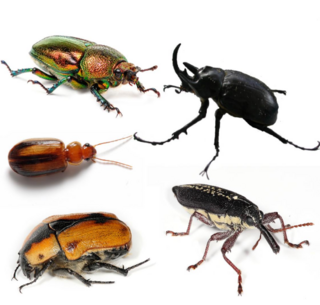
Beetles are insects that form the order Coleoptera, in the superorder Holometabola. Their front pair of wings are hardened into wing-cases, elytra, distinguishing them from most other insects. The Coleoptera, with about 400,000 described species, is the largest of all orders, constituting almost 40% of described insects and 25% of all known animal species; new species are discovered frequently, with estimates suggesting that there are between 0.9 and 2.1 million total species. Found in almost every habitat except the sea and the polar regions, they interact with their ecosystems in several ways: beetles often feed on plants and fungi, break down animal and plant debris, and eat other invertebrates. Some species are serious agricultural pests, such as the Colorado potato beetle, while others such as Coccinellidae eat aphids, scale insects, thrips, and other plant-sucking insects that damage crops. Some others also have unique characteristics, such as the common eastern firefly, which uses a light-emitting organ for mating and communication purposes

Spercheus is a genus of aquatic beetles which are placed in a family of their own, Spercheidae within the Hydrophiloidea. About 20 species are known from around the world except the Nearctic with the majority being from the Oriental and Afrotropical Realms.

A water beetle is a generalized name for any beetle that is adapted to living in water at any point in its life cycle. Most water beetles can only live in fresh water, with a few marine species that live in the intertidal zone or littoral zone. There are approximately 2000 species of true water beetles native to lands throughout the world.

Sphaerius is a genus of beetles in the family Sphaeriusidae, comprising 18 species. It is one of the two extant genera in the family, the other being Bezesporum. They are typically found along the edges of streams and rivers, where they feed on algae; they occur on all continents except Antarctica. Three species occur in the United States.
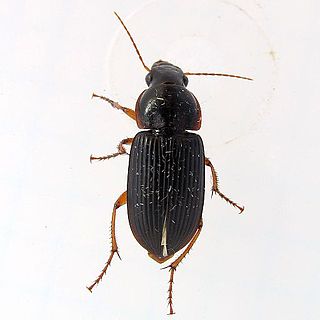
Harpalinae is the largest subfamily of ground beetles, containing more than 19,000 species worldwide.
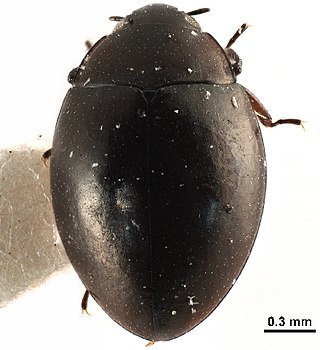
Myxophaga is the second-smallest suborder of the Coleoptera after Archostemata, consisting of roughly 65 species of small to minute beetles in four families. The members of this suborder are aquatic and semiaquatic, and feed on algae.
Yara is a genus of beetles in the family Hydroscaphidae, from South America and Central America. Containing five species:

Nosodendridae is a family of beetles, with less than a hundred species in three extant genera, which are found worldwide. Nosodendron, the largest genus, is found in forests and attracted to yeast generated slime on the wounds of trees, and likely consumes fermented substances as well as fungi and microorganisms. Several additional genera and species are known from the fossil record. Nosodendridae is considered to be an isolated lineage within Polyphaga, being the sister group to the clade containing Staphyliniformia, Bostrichoidea and Cucujiformia.
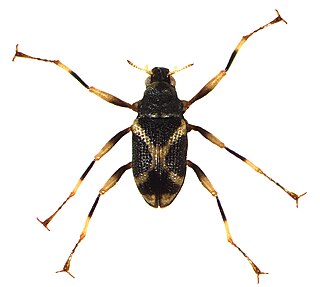
Ancyronyx, commonly known as spider water beetles or spider riffle beetles, is a genus of aquatic riffle beetles from North America, South Asia, China, and Southeast Asia. They are small beetles with extremely long legs ending in strong claws. Both the adults and the larvae are found underwater in the shallow riffles of streams and rivers, clinging to rocks or submerged wood. They feed on algae and decaying wood tissue. The genus contains twenty-one species, eleven of which are endemic to the Philippines.
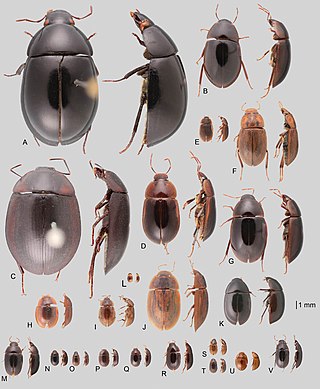
Acidocerinae is a subfamily in the family Hydrophilidae of aquatic beetles, and it contains over 500 species in 23 genera.

Menemerus mirabilis is a species of jumping spider in the genus Menemerus that lives in Ethiopia in areas of human habitation, including a house and a hotel. The species was first described in 1999 by Wanda Wesołowska. The spider is small and brown, with a carapace that is between 1.8 and 2.4 millimetres long and an abdomen between 2.0 and 3.5 millimetres long. The female has a larger and lighter abdomen than the male. The male has an indistinct leaf-shaped pattern on its abdomen. It is similar to other species in the genus but can be distinguished by its copulatory organs. The male has a shorter embolus than other species. The female can be identified by the two depressions in its epigyne and its circular spermathecae.
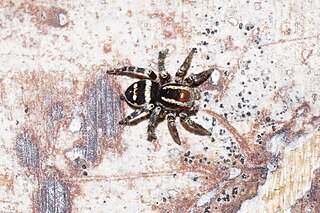
Stenaelurillus iubatus is a species of jumping spider in the genus Stenaelurillus that in endemic to Nigeria. It was first described in 2011 by Wanda Wesołowska and Anthony Russell-Smith. The spider is medium-sized, with a brown carapace between 2.7 and 2.95 mm in length and abdomen between 2.3 and 3.25 mm in length. The male has two stripes of white scales on the carapace and the female has a heart-shaped white spot on the abdomen. The spider has a distinctive mane-like long hairs on its black eye field, which is recalled in the species name that is derived from the Latin for mane. It can be distinguished from other species in the genus by the ribbon-shaped embolus on the male and highly sclerotized epigyne with its narrow pocket and widely separated copulatory openings on the female.

Saprininae is a subfamily of clown beetles in the family Histeridae. There are more than 50 genera and 800 described species in Saprininae.
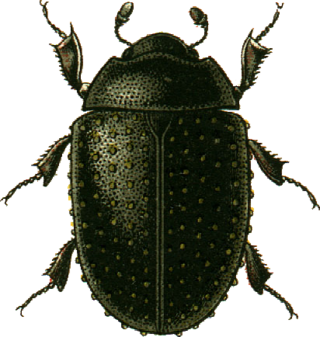
Nosodendron is a genus of wounded-tree beetles in the family Nosodendridae. There are more than 70 described species in Nosodendron.
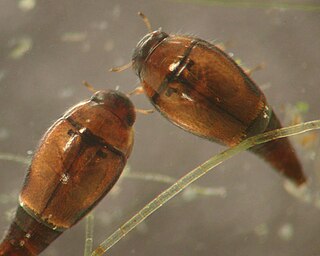
Hydroscapha natans is a species of skiff beetle in the family Hydroscaphidae. It is found in North America.

Epimetopidae is a family of semi-aquatic beetles belonging to the Hydrophiloidea. They are found in sand and gravel at the edges of streams, rivers and shallow freshwater ponds. These beetles are shorter than half a centimeter long and have a pronotum with a central projection forming a shelf above the head. On the underside of the abdomen only four sternites are visible. There are approximately 72 described species in three genera, Epimetopus which is restricted to the New World, mostly Neotropical, Eupotemus with two Afrotropical species and Eumetopus with some Oriental species. Females carry their eggcases on the underside of the abdomen. The larvae are probably carnivorous based on their mouthparts and likely live in the same habitats as the adults.
Hydroscapha jaechi, is a species of skiff beetle endemic to Sri Lanka.
Hydroscapha monticola, is a species of skiff beetle native to India and Sri Lanka.

Anoplognathus olivieri is a species of beetle within the genus Anoplognathus.
Confossa is a genus of water beetle in the family Hydroscaphidae, discovered in 2015 and endemic to South America.
















